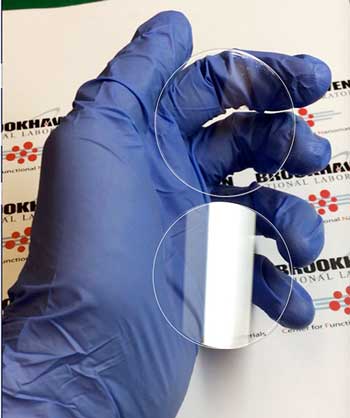| Posted: Jun 19, 2018 |
Can you see the invisible glass?
(Nanowerk News) Nanotextured glass surfaces can reduce light reflections to less than 0.2 percent across all visible and infrared light wavelengths. This reduction renders the glass essentially invisible—even at large viewing angles (Applied Physics Letters, "Self-assembled nanotextures impart broadband transparency to glass windows and solar cell encapsulants").
|
 |
| A piece of regular glass (lower) shows the reflection of an overhead fluorescent light. A similar piece of “invisible glass” (upper) does not reflect the overhead light and remains completely transparent. The outer edges of both glass pieces are circled in white, for clarity. (Image: Brookhaven National Laboratory)
|
|
These ultra-transparent windows could change cell phones, solar cells, and lasers. The material could enhance the experience of using consumer devices such as smart phones and televisions. Silicon solar cells encapsulated with “invisible glass” outperform conventional devices.
|
|
How? The material eliminates all reflection losses. Ultra-transparent laser windows with these nanotextures can withstand three times higher optical power than commercial broadband anti-reflection coatings.
|
|
Most optoelectronic components and consumer display devices require glass or plastic covers for protection against the environment. Optical reflections from these encapsulation layers can degrade the device performance or lessen the user’s experience.
|
|
In this work, scientists used a highly scalable self-assembly based approach to texture glass surfaces at the nanoscale, reducing reflections by such an extent as to make the glass essentially invisible.
|
|
The nanotextures provide broadband anti-reflection spanning across visible and infrared wavelengths (from 450 to 2500 nanometers) that is effective even at large viewing angles.
|
|
This technology can be used to improve the performance of solar cells by eliminating reflection losses, which can be as much as 8 percent for glass-encapsulated cells. Ultra-transparent windows with surface nanotextures on both sides can withstand three times more optical fluence than commercial broadband anti-reflection coatings, making them useful for pulsed laser applications.
|

